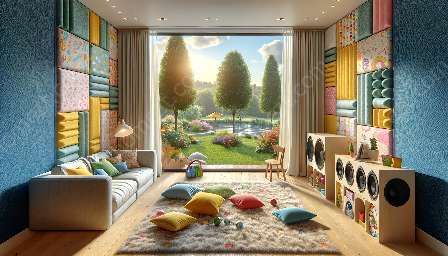Living in a noisy environment can have a significant impact on our well-being, especially in residential areas. Consequently, noise control regulations and guidelines play a vital role in creating a peaceful living environment. In this comprehensive guide, we will delve into noise control regulations and guidelines in residential areas, as well as strategies for managing noise in children’s and teens' rooms, and overall noise control in homes.
Noise Control Regulations and Guidelines in Residential Areas
Noise pollution is a common problem in residential areas, often caused by various sources such as construction activities, traffic, industrial facilities, and recreational activities. To address this issue, local governments and regulatory bodies enforce noise control regulations to protect the well-being of residents.
Regulatory Measures: Noise control regulations typically include specific guidelines regarding acceptable noise levels during different times of the day. These regulations may also incorporate zoning ordinances to designate areas for specific noise-generating activities, such as commercial or industrial zones.
Community Noise Guidelines: Additionally, communities may establish noise guidelines to ensure a peaceful living environment. These guidelines can address common sources of noise, such as loud music, barking dogs, and disruptive activities during designated quiet hours.
Enforcement and Compliance:
Enforcement of noise control regulations involves monitoring noise levels, investigating complaints, and taking appropriate action against violators. Compliance with these regulations is crucial for maintaining a harmonious community environment.
Noise Control Strategies for Children’s and Teens' Rooms
Children and teenagers require a quiet and calm environment for learning, rest, and relaxation. Implementing effective noise control strategies in their rooms can contribute to their well-being and overall development.
Soundproofing: One of the most effective strategies is soundproofing the walls, floors, and ceilings of children’s and teens' rooms. This can be achieved through the use of sound-absorbing materials, such as acoustic panels, carpeting, and drapes, to minimize sound transmission.
Strategic Furniture Placement: Arranging furniture strategically can help dampen noise and create a more peaceful atmosphere. Placing bookshelves, upholstered furniture, and rugs strategically can absorb and muffle sound waves.
Noise-Reducing Accessories: Utilizing noise-reducing accessories, such as thick curtains, sound-blocking door seals, and white noise machines, can help diminish external noise and create a serene environment for children and teens.
Establishing Quiet Hours:
Setting designated quiet hours, especially during study and bedtime, can promote a peaceful and conducive environment for children and teens. Encouraging family members to respect these quiet hours can further enhance the effectiveness of this strategy.
Noise Control in Homes
Managing noise within the entire home can significantly contribute to a tranquil living environment for all family members. Here are some effective noise control measures for homes:
Identifying Noise Sources: Begin by identifying the primary sources of noise within the home, such as appliances, HVAC systems, and external disturbances. Understanding these sources is crucial for implementing targeted noise control strategies.
Upgrading Insulation: Improving home insulation, particularly in walls, windows, and doors, can help reduce sound transmission between rooms and from external sources. Utilizing double or triple-pane windows and solid-core doors is an effective way to minimize noise infiltration.
Use of Soundproofing Materials: Incorporating soundproofing materials, such as acoustic foam, mass-loaded vinyl, and resilient channel, can be highly effective in minimizing noise transfer within the home.
Promoting Open Communication:
Encouraging open communication among family members regarding noise concerns and the need to respect each other's need for a peaceful environment can significantly contribute to managing noise within the home.
By implementing these noise control strategies and adhering to relevant regulations and guidelines, residents can create a serene and harmonious living environment for all generations, ensuring well-being and comfort in their homes.


